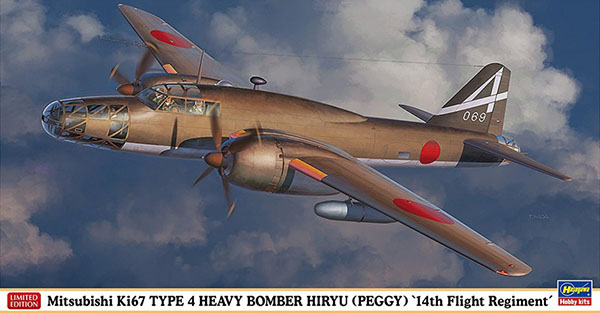
Hasegawa 1/72 Mitsubishi Ki 67 Type 4 Heavy Bomber Hiryu (Peggy) "14th Flight Regiment"
By Chris Banyai-Riepl
Overview
A great example of how rapidly evolving wartime conditions can change a design, the Mitsubishi Ki 67 Hiryu started out as an answer to an Imperial Japanese Army commission in 1939 for a new heavy bomber. The company took that challenge on with aplomb, improving beyond the initial requirements and delivering an impressive prototype that took to the air in December 1942. By the time it entered production in 1944, though, the war situation had changed and as a result, nearly all of the Ki-67 aircraft were switched over from a bomber role to that of a torpedo bomber. With the introduction of B-29 raids over Japan, the Hiryu was adapted to strike those Superfortress bases on Saipan, removing all but the rear defensive armament and adding extra fuel tanks to handle the range. This was a case of too little, too late, though, and their impact against American forces was minimal.
The Kit
Hasegawa's kit of the Mitsubishi Ki-67 Hiryu is easily the best choice for this aircraft in 1/72, with the only other real competition being the decades old LS (later reboxed by Arii) kit. The model features a fairly complete, if simple, interior and recessed panel lines throughout. This release provides parts in resin to build it as one of those long-range Saipan raiders, and the decal sheet provides markings for three aircraft, all from the 14th Flight Regiment.
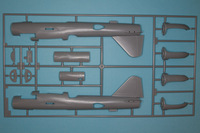
|
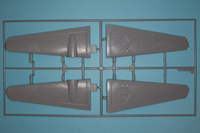
|
Starting construction with the interior, this kit provides a solid base to work from there is a one-piece floor, on which is added the fuel tanks, radio station, three seats, and two control columns. There is an additional front plug that has a separate instrument panel and bombardier station. Decals provide the instrument details for both the main panel and the radio station. Overall this is typical of a 1990s Hasegawa kit, with all the basics there, but lacking in detail. While the canopy is fairly heavily framed, a bit of extra work on the interior here would help out quite a bit in the realism of the finished model.
The completed interior gets sandwiched between the fuselage halves, and there are inserts for the rear teardrop gun emplacements. The upper rear cover is provided in resin. Once the main fuselage is together, attention turns to the wings. The engines are creatively done and provide a realistic appearance of the Ha-104 engine in its tight cowling. The exhausts are separate, which fit behind a cowl flap/engine piece. A separate front hub assembly is all that's left, and once placed into the one-piece cowl and covered up by the large spinner and impeller, you'll have an excellent representation of the engine hinted at around the edges. This cowl then fits up against the two-piece nacelle, which also forms the main wheel well. Like the cockpit, the main wheel well is sparse on detailing.
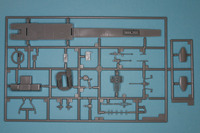
|
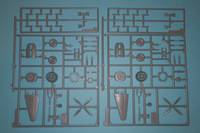
|
On the underside, the main gear does have some nice strut detailing, and features split right/left halves for the wheels that also have flattened spots. The bomb bay doors can be displayed open or closed, and the wing drop tanks are provided as one-piece resin assemblies. For those who want to show off more than just drop tanks, the kit also comes with fifteen 50-kg Ta-bombs for the bomb bay.
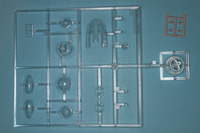
|
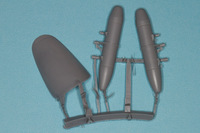
|
Moving on to clear parts, the nose piece has a separate end cap and another detail insert for the bombardier position. The rear piece also has a separate end cap and gets a 12.7mm machine gun as well. The main canopy piece features separate top hatches that can be displayed open or closed. If nothing has been enhanced on the cockpit, I would recommend keeping these closed. Finally, there is a separate insert for the top of the fuselage that has a DF antenna.
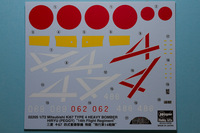
|
Moving on to the markings, all three options provided in the kit, as noted, are from the 14th Flight Regiment, and all have the same camouflage of an olive drab over Mitsubishi green-gray. The first is 069 from the 1st Squadron at Irumagawa Air Field, Saitama Prefecture in August 1945. The second is 062 from 2nd Squadron at the same location as the first. The final option is another example from 1st Squadron, this time 486 at Nitta Air Field in Gunma Prefecture in August 1945. The only difference between options is the tail markings, with the 1st Squadron having white markings and numbers, and the 2nd Squadron having red outlined in white.
Conclusion
The Mistubishi Ki-67 Hiryu is an interesting aircraft with an interesting history, and it is good to have this accurate kit available to us. For those who want to overcome the detail deficiency, there are photoetch sets available, and at the very least I would recommend picking up one of the pre-cut canopy mask sets that are out there. My thanks to Hasegawa USA for the review sample.
